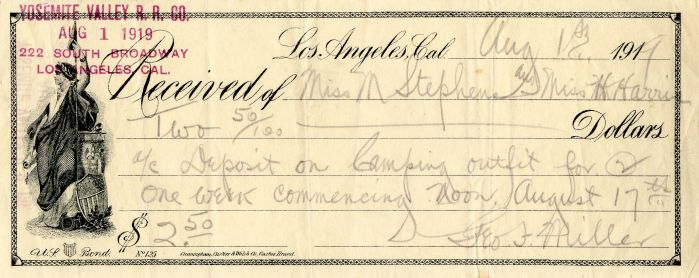Yosemite Valley Railroad Co. - Railroad Receipt
Inv# CKR1051 Agreement
Railroad Receipt. Los Angeles, California.
The Yosemite Valley Railroad (YVRR) was a short-line railroad operating from 1907 to 1945 in the state of California, mostly following the Merced River from Merced to Yosemite National Park, carrying a mixture of passenger and freight traffic. Contrary to the name of the railroad, rail service did not extend to Yosemite Valley itself, but rather ended at the park boundary as the construction of railroads is prohibited in the National Parks. Passengers would disembark at the park boundary in El Portal, CA and take a stage coach, and starting in 1913 a motor coach, to Yosemite Valley itself. With closure of the Yosemite Sugar Pine Lumber Company in 1942 and the sale of the Yosemite Portland Cement Company to the Henry J. Kaiser Company and subsequent suspension of all operations in 1944 led to a loss of most of the freight track on the railroad. This in addition to the increased competition for passengers from use along the Yosemite All-Year Highway (now designated as California State Route 140), both commercial and private, and the substantial decrease of recreational passenger traffic because of World War II led to the downfall of the railroad. The railroad asked the Interstate Commerce Commission for permission to abandon operations on October 25, 1944. The last regularly scheduled train ran on August 24, 1945.
The railroad was incorporated on December 18, 1902, by John S. Drum, William B. Bosley, Sydney M, Ehrman, Thomas Turner, and Joseph D. Smith in the city of San Francisco. It was a standard-gauge railway that stretched about 30 miles (48 km) from Merced to the mouth of Merced Canyon, connecting the towns of Snelling, Merced Falls, Exchequer and Bagby, and a further 50 miles (80 km) to El Portal, CA. Aside from passengers and mining products, the railroad also carried lumber (from the Yosemite or Sugar Pine lumber companies) to Merced Falls, to be cut at a group of sawmills at a cataract on the Merced River.
In 1926, the construction of Exchequer Dam flooded part of the railroad under Lake McClure, but the railway was rerouted around the reservoir afterwards. In the mid-1940s floods and landslides damaged nearly 30 miles (48 km) of the railway in Merced Canyon. Sections of the re-routed railbed were again put under water when Exchequer Dam was expanded in the 1960s. Several tunnels for the railroad still remain under Lake McClure, and are visible when the water level drops during drought periods. A few other tunnels in Merced Canyon are now used for road traffic.
Among many notable passengers, the YVRR carried two presidents: William Howard Taft in October, 1909 and Franklin Roosevelt on July 15, 1938.
The National Park Service relocated several surviving structures, including the original hand-turned turntable, from Bagby to El Portal. One of the few surviving pieces of rolling stock, Caboose No. 15, is also located at El Portal. Locomotive 29 also survives, being sold to a Mexican railroad after the YV's closure and is presently on static display in Veracruz, Mexico.










Ebay ID: labarre_galleries